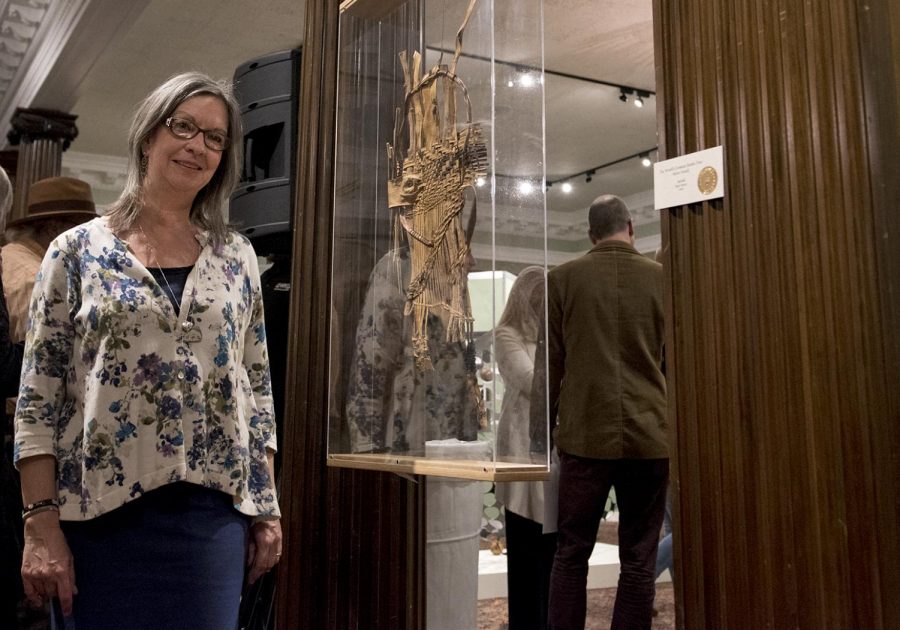Basket weaver Beth Hester discusses her craft
March 6, 2017
When Beth Hester and her husband Scott Gilbert got married about 37 years ago, they found a passion and purpose as they built their lives together: basket weaving.
Hester was born in Logan County and she grew up in Goodlettsville, Tennessee. Her love of handwork began when she was about six or seven years old. Her grandmother lived with her as a child. Her mother and grandmother both sewed, which got Heston interested in sewing.
“I’ve always loved sewing, and I’ve always loved handwork and Scott, my husband, says I was born with a needle in my hand,” Hester said.
Hester and Gilbert moved to Allen County when they got married. When they began looking for their calling, Gilbert inherited a basket from his grandmother.
As Hester and Gilbert learned more about basketry, they discovered the basket was made by members of a Cherokee Native American tribe. When Gilbert began crafting baskets, his first baskets were similar, and he began splitting white oak.
Hester and Gilbert met Ollie and Lestel Childress, who were fourth and fifth- generation basket makers. The Childresses are now deceased.
Intrigued by basket making, Gilbert asked Lestel if he would teach him how to make baskets. Lestel agreed to teach him everything he knew if Scott promised if Lestel’s grandchildren ever wanted to learn how to make baskets, Gilbert would teach them.
As fate would have it, because the Kentucky Museum has a basket exhibit called “Standing the Test of Time: Kentucky’s White Oak Basket Tradition,” Heston and Gilbert met one of Lestel’s grandsons at the Kentucky Museum’s annual Celebration of the Arts exhibit this year, where Hester won the The World’s Greatest Studio Tour Merit Award for a fiber arts piece she entered into the show.
Lestel’s grandson wants Gilbert to teach him how to make baskets using white oak.
“This is a connection that has been made after all of these years, and we are really, really thrilled about it,” Hester said.
In the last 10 years or so, Hester has started working with new materials. She studied with Alfred Schneider, the retired director of a basketry school in Lichtenfels, Germany about 15 years ago. She visited Lambesc, France for willow workshops taught by Eva Seidenfaden and Ane Lyngsgaard, Danish weavers who lead workshops in France, Denmark and the United States.
“It’s through willow that I feel I have found a material that really works with me, and I work well with it, and I can express myself as an artist … in a new and exciting direction for me,” Hester said.
Hester submitted a piece into the Celebration of the Arts exhibit last year, and won first place in fiber arts last year with a piece called “Willow’s Rhythm.” She called this year’s piece, “Untitled.”
“Untitled” utilizes willow bark in a way that is flat and has an unexpected blend of textures and shapes. Hester has not decided what the piece depicts, but she has somewhat of an interpretation.
“The spruce root that encircles part of it – I think of that as an embrace,” she said.
Jane-Allen McKinney, associate professor of sculpture at Tennessee State University in Nashville, and she judged many of the pieces at Celebration of the Arts this year. She enjoyed Hester’s piece.
“She used that technique for a whole other way of working, which was very clever, and what I really enjoyed about it,” McKinney said.
She interpreted Hester’s piece as a portrait of a person’s face.
“That was very exciting, and the presentation was beautiful,” she said.
McKinney encouraged Hester to display her work in other exhibits, including those in Nashville and across the country.
Hester and Gilbert own The Basket Maker’s Catalog in Scottsville with their partner Michael Sims. They started the business about 35 years ago, which offers workshops and materials.
Hester received a degree in elementary education from the University of Tennessee and a master’s degree in folk studies at WKU. For over two years, she has served on the Board of Directors of the National Basketry Organization. The biennial conference will occur this July in Tacoma, Washington.
Hester’s “Untitled” was inspired by the many visits she and Gilbert have taken to southeastern Utah, where they hike, enjoy the solitude and look for rock art and old Native American habitation sites.
“I’ve wondered over the past few years … if there would ever be a way that something that I would make would reflect the meaning that I find in being in those places and the feelings that I have, and when I finished that piece, I felt that I had reflected somewhat that southeastern Utah experience, and it pleased me,” she said.
Though Hester did not begin working on her piece with a particular goal in mind, she knew she wanted to create a flat, woven piece of art, and it emerged as she worked on it.
“That was a really satisfying experience also, not to know where I was going but to end up in a place that was meaningful to me,” she said.
Reporter Olivia Mohr can be reached at 270-745-6288 and [email protected]




















![Megan Inman of Tennessee cries after embracing Drag performer and transgender advocate Jasmine St. James at the 9th Annual WKU Housing and Residence Life Drag Show at Knicely Conference Center on April 4, 2024. “[The community] was so warm and welcoming when I came out, if it wasn’t for the queens I wouldn’t be here,” Inman said.](https://wkuherald.com/wp-content/uploads/2024/04/smith_von_drag_3-600x419.jpg)


